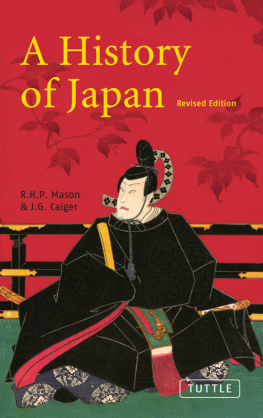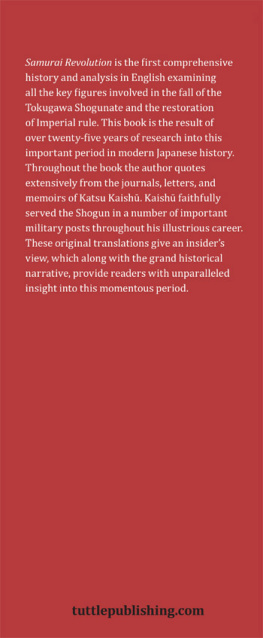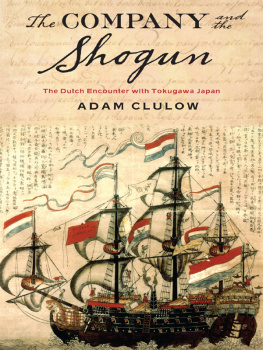THE FURTHEST GOAL
ENGELBERT KAEMPFERS ENCOUNTER WITH TOKUGAWA JAPAN
THE FURTHEST GOAL
ENGELBERT KAEMPFERS
ENCOUNTER WITH
TOKUGAWA JAPAN
_________________
BEATRICE M. BODART-BAILEY
DEREK MASSARELLA
THE FURTHEST GOAL
JAPAN LIBRARY
Knoll House, 35 The Crescent
Sandgate, Folkestone, Kent CT20 3EE
Japan Library is an imprint of Routledge
St Johns Studios, Church Road, Richmond, Surrey TW9 2QA
Transferred to Digital Printing 2005
First published 1995
Japan Library 1995
All rights reserved. No part of this publication may be reproduced, stored in a retrieval system, or transmitted in any form or by any means without prior permission of the publishers, except in brief passages in criticism.
British Library Catalogue in Publication Data
A CIP entry for this book is available
from the British Library
ISBN 1-873410-37-9
Typeset by Bookman, Slough, in Garamond 12 On 13 pt
Contents
Acknowledgements
THIS BOOK has its origins in a symposium to mark the three-hundredth anniversary of Engelbert Kaempfers arrival in Japan held in Tokyo in December 1990. The symposium was organized jointly by the Philip Franzvon-Siebold Institut fr Japanstudien, Tokyo, and Beatrice Bodart-Bailey. Most of the chapters are much revised versions of papers given there.
While writing and editing we have received institutional support from the Department of East Asian Studies of Princeton University, the Institute of Social Science of the University of Tokyo, the International Research Center for Japanese Studies, Kyoto, the Japan Foundation, and the Research School of Pacific and Asian Studies of the Australian National University. A number of individuals have been most generous either with support and encouragement or in making a number of valuable suggestions for improvement. Most of these are mentioned in the footnotes, but in addition the editors would like to thank George Akita, Josef Bohaczeck, Michael Cooper and Marius B. Jansen.
Derek Massarella, Tokyo
Beatrice M. Bodart-Bailey, Canberra
List of Contributors
CARMEN BLACKER was a Lecturer in Japanese at Cambridge University from 1958 to 1991. Her books and articles on Japanese religion and folklore include The Catalpa Bow: a Study in Shamanistic Practices in Japan, 1975. She is a Fellow of the British Academy.
BEATRICE M. BODART-BAILEY is a Research Fellow in the Research School of Pacific and Asian Studies of the Australian National University. She is the author of Kenperu to Tokugawa Tsunayoshi, 1994, and numerous articles. She is preparing a new translation of Kaempfers History of Japan.
DEREK MASSARELLA is a Professor in the Faculty of Economics of Chuo University, Tokyo. He is the author of A World Elsewhere: Europes Encounter with Japan in the Sixteenth and Seventeenth Centuries, 1990, and numerous articles.
WOLFGANG MUNTSCHICK is an editor at the Deutscher Apotheker Verlag, Stuttgart. He is the translator and editor of Kaempfers Flora Japonica and Phoenix persicus, and author of numerous articles.
JRG SCHMEIER is Head of the Printmaking Workshop, Institute of the Arts, Australian National University, Canberra. He is an internationally renowned artist with many solo exhibitions to his credit.
PAUL VAN DER VELDE is the editor for the International Institute for Asian Studies, Leiden. He has edited six volumes of Deshima Dagregisters: Their Original Tables of Contents in the Intercontinenta series of Leiden University, and is the author of numerous articles on colonial history.
Abbreviations
| Add. | British Library, London, Additional Manuscript. |
| Amoenitates Exoticae | Engelbert Kaempfer, Amoenitatum exoticarum politico-physico-medicarum fasciculi V, , Lemgo, 1712. |
| ARA/VOC | Algemeen Rijksarchief, The Hague, 01.04.01, Het Archief van de Vereenigde Oostindische Compagnie, 1602-1796. |
| BL | British Library, London. |
| Bodl. | Bodleian Library, Oxford. |
| Dohm | Engelbert Kaempfer, Geschichte und Beschreibung von Japan, edited by Christian Wilhelm von Dohm, 2 vols, Lemgo, 1777-79, reprint Brockhaus, Stuttgart, 1964. |
| IOR | India Office Library and Records, London. |
| NFJ | Algemeen Rijksarchief, The Hague, 01.04.21, Het Archief van de Nederlandse factorij in Japan, 1609-1860. |
| Or. | British Library, London, Oriental Collections. |
| Scheuchzer | Engelbert Kaempfer, The History of Japan, translated by J. G. Scheuchzer, repr., 3 vols, Glasgow, 1906. |
| Sl. | British Library, London, Sloane Manuscript |
| VOC | Vereenigde Oostindische Compagnie (Dutch East India Company). |
CHAPTER ONE
Introduction: The Furthest Goal
B.M. Bodart-Bailey
FEW DESCRIPTIONS of foreign countries have stood the test of time so well as Engelbert Kaempfers work known in English as The History of Japan.frequently cite Kaempfers account, for it contains material not covered in Japanese sources.
Yet in spite of the acclaim The History of Japan has received, relatively little research has been published about the author, his personal encounter with late seventeenth century Japan and the way this experience came to reach the public in the form of the well-known work. In view of the paucity of material on Kaempfers life, especially in English, a brief biographical sketch as background information for the more detailed studies that follow is in order.
KAEMPFERS EARLY LIFE (1651-1683)
Engelbert Kaempfer was born in 1651, the second son of the pastor primarus, the senior vicar, of the merchant town of Lemgo in Westphalia. The cathedral-sized church and the richly decorated masonry of the houses lining the market and the main thoroughfare still bear witness to the former importance of this now somewhat isolated rural township. Kaempfers father came from an established family and was an educated man. Like his sons he had been a pupil at the local Latin school. Later, he studied at Rostock University and eventually obtained a masters degree. Aged only thirty-four he was promoted to the important post of senior vicar.
Kaempfer grew up in a relatively privileged environment. Although his position as vicar did not permit the father to accumulate great material wealth, he did possess a well-stocked library containing, amongst other valuable works, Adam Oleariuss account of Duke Friedrich von Holstein-Gottorps mission to the court of the Shah of Persia in 1635-39.
Not just Kaempfers life, but also the careers of his brothers testify to the stimulus provided by their childhood environment. Kaempfers brothers and stepbrothers were all widely travelled and had distinguished academic or official careers; his eldest brother Joachim taught at Leiden University and was later mayor of
The earliest extant written words in young Engelberts hand are those on his elder brothers matriculation essay. Phoebe will reward you if you continue the way you have begun wrote the fourteen-year-old boy. The title of the matriculation essay was Twenty-four Postulates against Atheism, The tolerance Kaempfer later displayed towards non-Christian religions might well have received its first stimulus from discussions held at the vicarage.










